HistoryReal USP is a product of Heckler & Koch. It had quite a long way from the drawing board to USP as we know it.
American branch of HK created a list of features that were desired in a pistol. In late 1980s the whole world looked at 9mm "wonder nines", but HK decided to use stronger .40 S&W ammo. Design process started only in 1989, when it was clear that Cold War has come to an end, and military customers will not purchase as much as previously. The first steps were to observe market, competition, and analyse them. It soon became clear that converting 9mm pistol to .40 S&W ammo is not an easy thing to do - not to mention .45 caliber.
Meanwhile US SOCOM was looking to replace Colt 1911 with another .45 pistol that could be used in special forces. Slow .45 ammo is easier to make quiet while still stable. New pistol was supposed to be compatible with LAM (Laser Aiming Module) and silencer modules developed by two other companies. Only two companies fulfilled requirements: Colt with a modified Double Eagle and HK with a larger variant of the pistol they were already designing.
In 1992 HK provided 30 prototypes of their pistol, now called "365-days pistol" because SOCOM delayed delivery date to give Colt a chance to participate. Even before Colt was able to supply prototypes it was clear that HK pistol was just impossible to kill in use. Water, sand, dust, +65C, -40C, mud, ice, salt, lack of oil, drops on hard surface, even dragging behind a car could not make these pistols fail. It even survived the hardest test: a bullet was pushed into the barrel, and another one was fired through it. Both bullets left barrel, there was only a slight swelling and pistol continued to shoot correctly.
The first serial production pistols entered service in 1996, they were known as SOCOM Mk23 Mod 0. Meanwhile HK went bankrupt and got bought out by British Aerospace.
The .40 pistol that HK originally worked on was now called USP, Universal Selfloading Pistol. It avoided problems with 9mm to .40 conversions that other manufacturers tried, but it made USP (with its .45 and 9mm variants) much larger than 9mm pistols and did not become very popular in Europe. As a result of size complaints in 1996 HK released USP Compact, a smaller version. Once again it was something different - rather than cutting grip and slide, HK designed it from scratch, just reusing ideas from larger USP.
The next version was USP Tactical. Frame was based on USP45, but slide was once again built from scratch, based on SOCOM Mk23 variant. Later on a multitude of versions were released, based on success of the original models: USP Compact Tactical, USP Custom Sport, USP Match, USP Expert and finally USP Elite.
Wikipedia information about HK USP:
http://en.wikipedia.org/wiki/Heckler_%26_Koch_USPMore information:
http://world.guns.ru/handguns/hg11-e.htmModelgunWhile USP seems to be very popular in airsoft world, there is only one modelgun, released by Tanaka. It is a full-size USP model, but chambered in 9x19mm instead of original .40 S&W. Tanaka released modelguns of Sig P226, Glock 17, Glock 18 and then USP in 1999 as ABS version. In 2003 there was a second release, this time HW version. Due to more delicate nature of HW the third release in 2005 was mixed: slide was made from ABS to better withstand stress, while frame remained HW.
Japanese pages with information about this model:
http://homepage3.nifty.com/nkoinuma/HK.htmhttp://web3.incl.ne.jp/shiraaya/tanaka-usp.htmI did not have particular interest in USP, as I thought it is just a modern pistol not much different from Sig P226. However when I visited friend who had airsoft KSC USP and USP Compact I found that these are very nice replicas indeed. USP Compact was a tad too small to hold comfortably, but full-size one felt just right.
As often happens with hobbies, one day a chance to buy a Tanaka USP form a forum member came up. This is the last revision, with ABS slide but HW frame.
BoxBox is black, with white lettering. Top says "H&K USP", "Semi-automatic Pistol", as well as Tanaka logo and "MANUFACTURED BY THE TANAKA WORKS TOKYO". There is also a white sticker with Japanese text saying its a hybrid model with HW frame "fu-re--mu-he-gu-i--u-e-i-to" and ABS slide. Sides have various text in Japanese and English, including "PLASTIC MODEL GUN", "SPG" and SPG certification sticker.
Top cover is carton, bottom part styrofoam, with cutouts for pistol and cartridges. There is also cartridge loading tool, manual and additional leaflet clarifying how to load cartridges correctly - it was not done well enough in the manual.
Loading tool is used for pushing 5mm caps into cartridges.

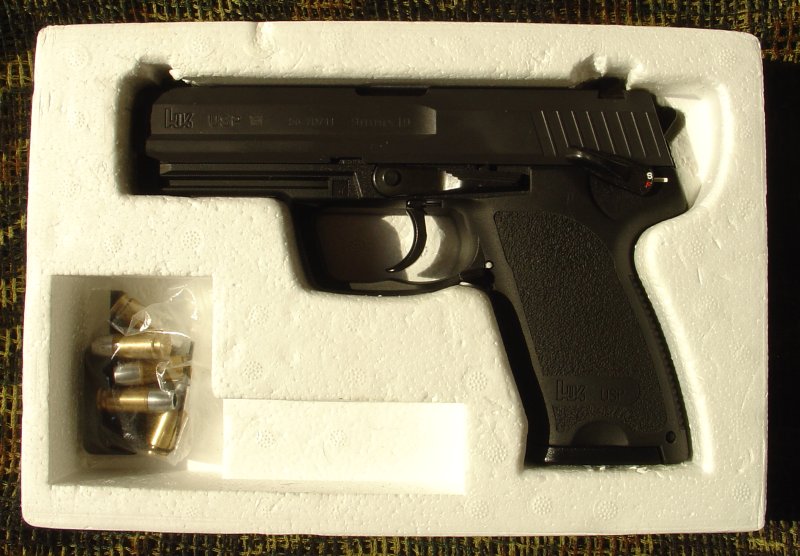
Manual has 10 pages, showing in pictures all important things about handling of the modelgun, as well as an exploded diagram, list of parts, spare ordering page and other information. Cartridge loading section has two problems: first of all loading tool has slightly changed in reality, it no longer has a side piece to push piston pin into the cartridge. Additional page shows how to push it using a hard flat surface. The second part clarifies how to put insert into the shell - one side is longer and it should face up, while in the older design it was more symmetrical.
It could be that HW is different than ABS, or that design changed in some point of time, or cartridge design changed after printing manuals, but before producing models. Could be interesting to find out :-)
Manual and leaflet are marked with "1999.9", giving a year and probably month of manual issue. Manual does not seem to have changed between releases.
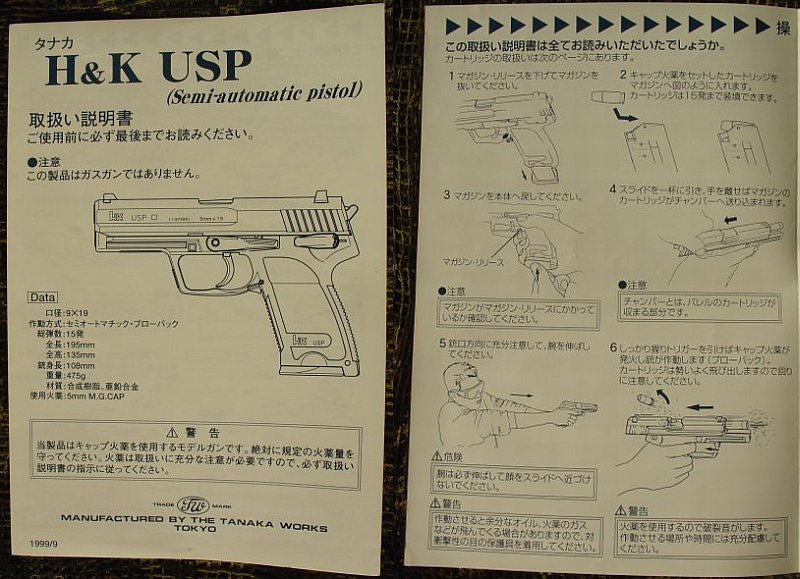

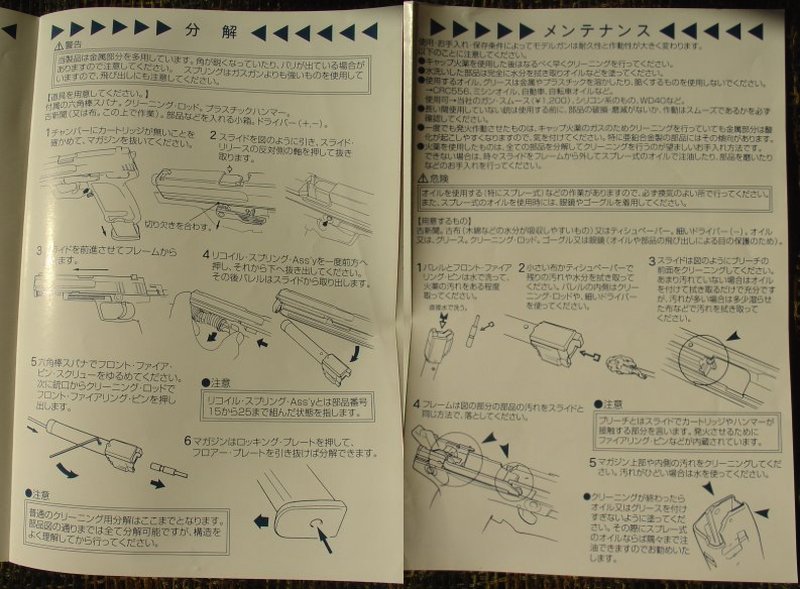


 Modelgun
ModelgunTanaka USP looks like an USP :-) It is a 9mm version of full size pistol, featuring a lot of original markings.
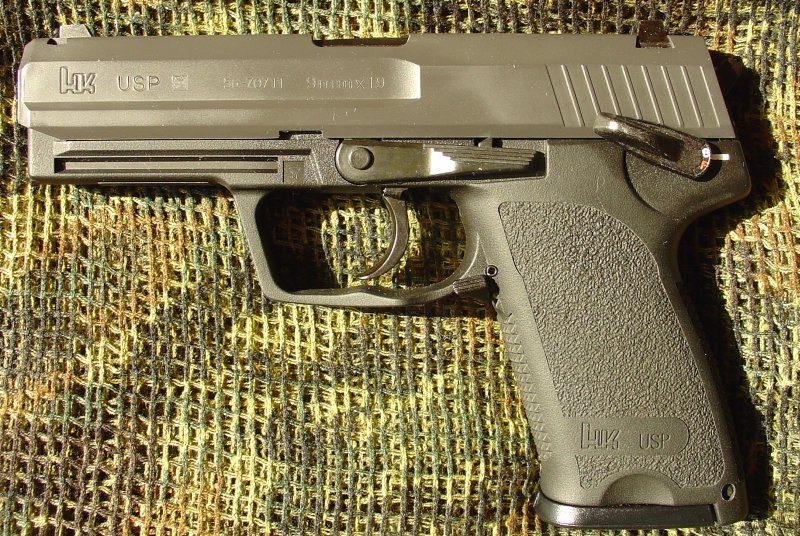

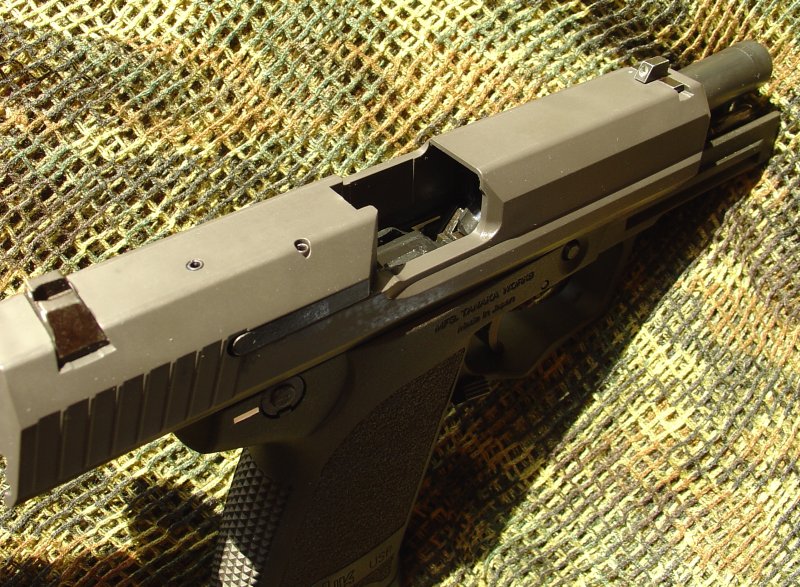

When I first saw this model, several things stood out for me - the first was that Tanaka put there plenty of original markings!
Left side of the slide is marked with: HK logo, "USP" designation, square stamp with "ami ns" letters underneath a stylized bird (eagle?), serial number "56-70711" and caliber marking "9mmx19".

Right side of the chamber is stamped with: HK logo, caliber "9mmx19", "Bundesadler" which is Federal German eagle logo containig letter "N" and a serial number "56-70711". "N" letter stands for Nitrocellulose - meaning this pistol (but not model, obviously) is designed to use such ammo.
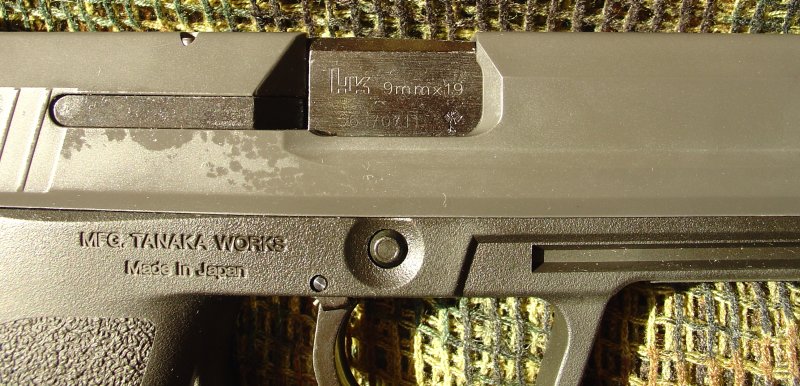
Left side of frame has a barely visible Bundesadler in front of slide lock lever. Right side of frame has modelgun-specific marking saying "MFG. TANAKA WORKS" and "Made in Japan". Bottom of frame, under barrel, bears "MFG. TANAKA", "SPG" logo (Safe Plastic Gun) as well as an inlaid metal tab with serial number: "56-70711". This tab is similar to what you find in Glocks. Trigger guard is marked with "WARNING REFER TO OWNERS'S MANUAL" stamped underneath.
There is also HK logo under the magazine.
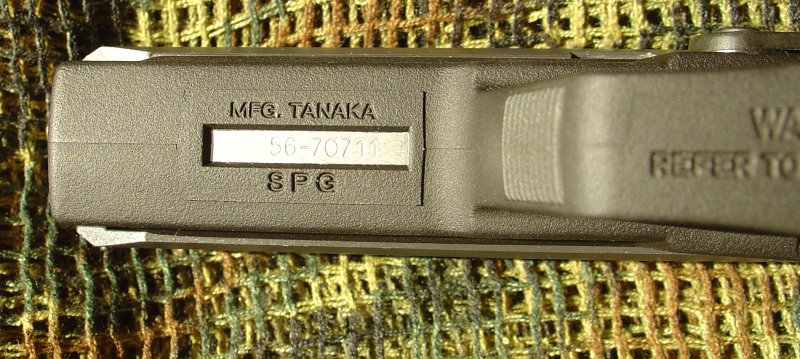
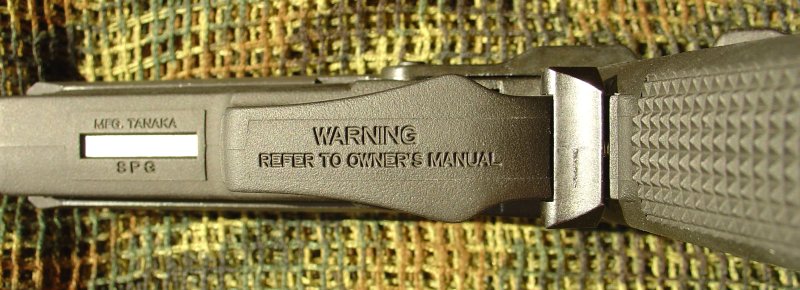
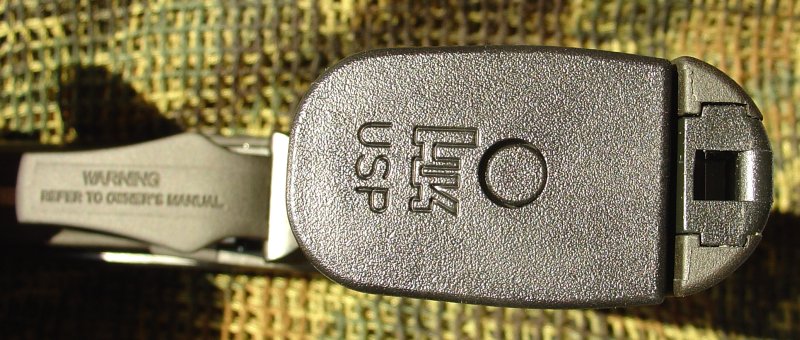
According to list of HK serial numbers found on this page, prefix "56-" is not assigned, so Tanaka probably decided to use it for modelgun for that reason.
http://hkpro.com/index.php?option=com_content&view=article&id=137:the-symbols-on-hk-firearms&catid=4:special-topics&Itemid=5Ufff, that's a lot of markings for a modelgun!
Grips are marked with HK logo and "USP" text on both sides. Supposedly this was only used on the earliest real USP, later text on one side was changed to patent listing. They have a rough "sanded" pattern to help holding it. Front and back of the grip also have pyramid-shaped protrusions that are supposed to make holding it in hand easier. Forgot to mention one important thing - there is no grip panels. Everything is moulded together with the frame, from the same (hard) plastic! Depends on your taste, I do not like that - surface is not nice to hand, and you can't replace it with Pachmayr or other grips.
At the bottom of the frame, just above magazine bottom you will find two indentations made for fingers - to help take out magazine, I suppose. The bottom-back corner of the grip has a hole for a lanyard.

Trigger is very wide compared to other pistols. USP works in double- and single action. In double-action trigger pull is very heavy as it moves the hammer, and past the point when it fires. In single-action when hammer is already cocked, trigger stays about half-way towards the back and it has a bit of slack. Pull is very hard however.
Trigger guard is also very wide, with an extre width in the middle - no idea what it's for. Inside of the trigger guard I could find the only visible casting fault.
Magazine release lever sits under the trigger guard - not very usual place and unusual action. It is not a button to push, but a lever that you have to move downwards. Advantage is that you can use it from both side of the pistol without modifications, I guess. Lever is quite hard to push, and (probably due to mechanism design) it seems to go off in two stages - magazine first drops a little (but you can't pull it out yet), than it is released completely.
Concept of the lever seems similar to Walther P99, but I find it less convenient and not as elegant.
Frame in front of the trigger guard, under barrel, has a rail on which you can mount accessories. However this is a special HK style rail that only works with HK accessories due to specific width. To use standard rail accessories you need to buy an adapter to a Weaver or Picatinny rail system.
Over the trigger you will find a slide lock lever (on the left side). It locks slide back on empty magazine, when a "tooth" enters notch in the slide. This lever also holds slide to the frame - for disassembly you need to push it out from the pistol, starting on the right side, where a small indentation is to aid it in the task.
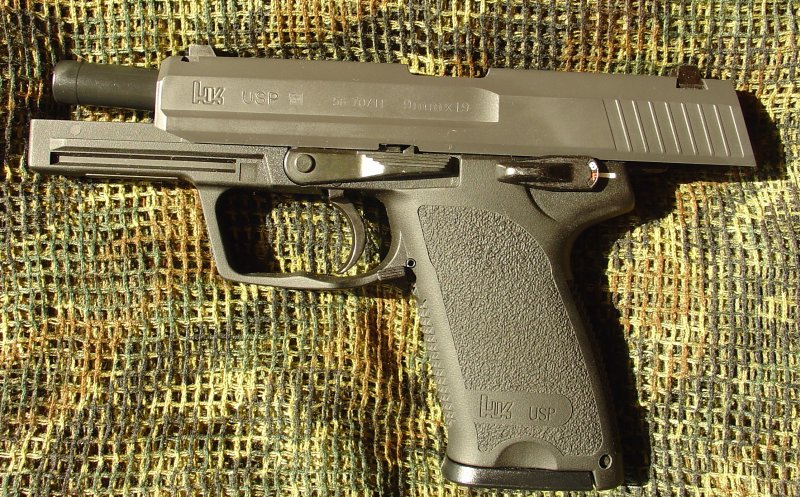
Safety switch sits near the end of the slide, behind slide lock lever. It is very large for pistol, and it protrudes quite a lot to the side for some reason. Frame is marked with a white line, and a single letter on safety switch aligns with this line to tell you which mode pistol is in: white "S" for safe (switch up) or red "F" for firing (switch down). Modelgun also replicates the third function of a real switch: when you push the switch down behind "F" position, it acts as a decocking lever and releases hammer (similar to Sig P226).
When in safe position and hammer is release, you can pull trigger and hammer will travel back, but it will not reach the point of falling. As you release trigger, hammer will also move to its resting position. If hammer was cocked, you will not be able to pull trigger and release hammer.
Switch is on the left side, but it looks that it can be moved to the right side - you see there another white line on frame, and the other end of axis.
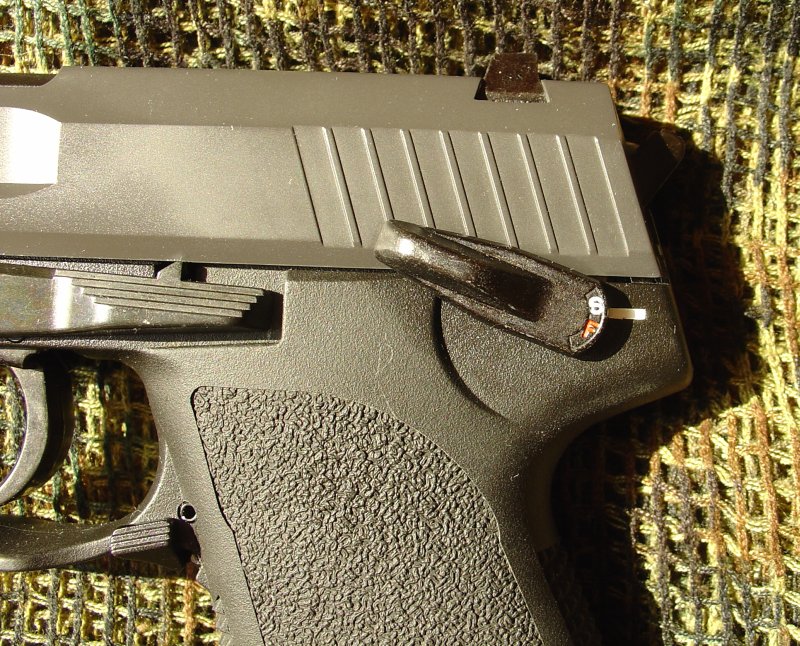
Slide is squarish, but with additional shapes along the sides. Back of the slide has serrations to make cocking it easier, but they are fairly shallow and symbolic, unlike these in Colt, Glock or other pistols.
There is an ejection port, with an extractor visible right behind the port, on the right side.
Simple sights are mounted (dovetail) on top of the slide. Sights have white dots, two at the back and one at the front.
Hammer protrudes just a bit out of the back, enough to cock it manually. I found that there is a bit of wobble when it's in top position, you can move it back and forward by about 5mm.

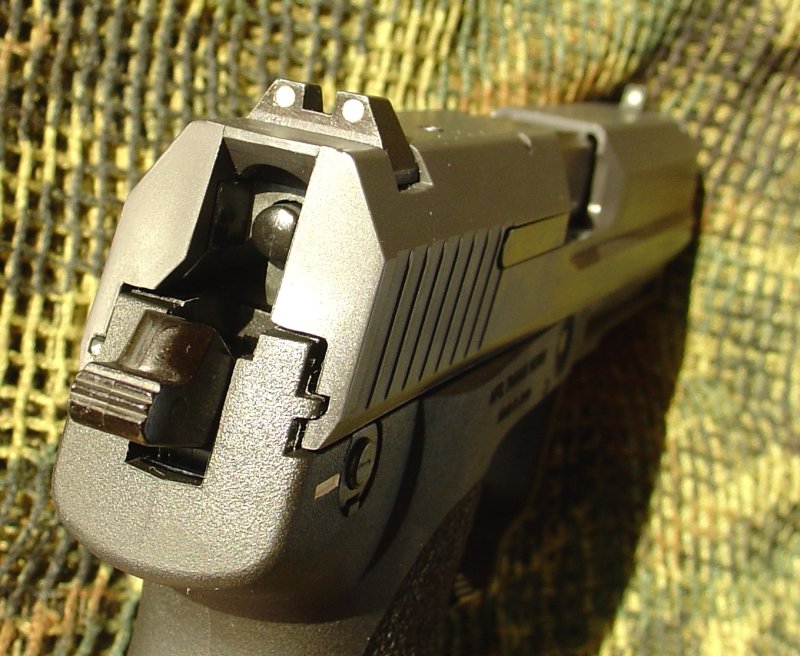
Barrel is plastic, with a usual metal tab inserted in the middle. Chamber, however, is quite surprisingly made of metal. On top you can even see machining marks. It is a metal sleeve that is pushed over barrel end and held by a grub screw. When slide is locked back, barrel is tilted upwards - it is normal, no need to worry.
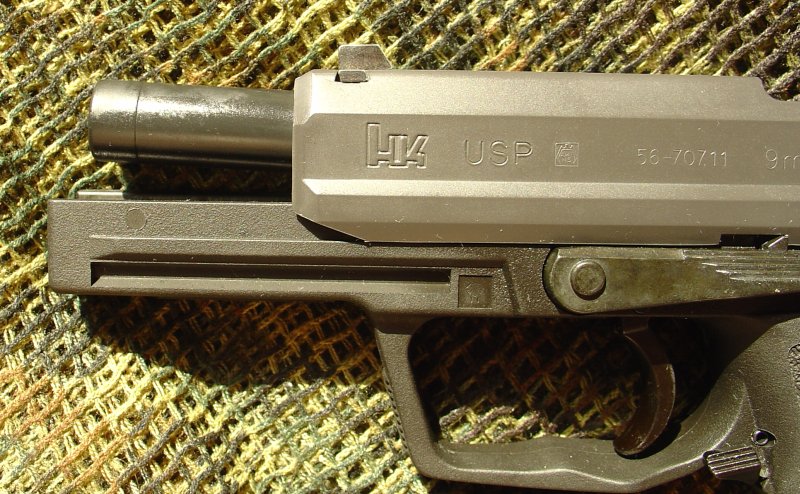
Frame in this model is HW, slide ABS, while levers, trigger, hammer, extractor, chamber and sights are metal. Everything is black, with slightly different shades on slide (lighter colour) versus frame and metal parts. Finish is matte, with frame being "sandy" and slide much smoother, yet not shiny-smooth. On photos due to sun shining on plastic it seems to be more gray than black.
Moulding lines are slightly visible in some of the usual places, but for example slide has them at corners, so they do not stick out so much. Frame has one line through the middle. The only large artefact is inside the trigger guard, as mentioned
MagazineIt's... plastic???
Yes, plastic... disappointing. Usually in a plastic model you find a metal magazine to add some weight in a correct place. Tanaka has choosen to replicate more closely polymer magazine of H&K USP, making it very light (even when loaded). USP model feels unbalanced, slide-heavy.
Magazine is marked with HK logo and "USP" text at the bottom, as well as "9x19" caliber on left side and letters "TA" under caliber.
Magazine is made from a few parts - main body, bottom plate, inside plate, spring, follower. Only spring is metal. To remove insides you press button in the bottom and slide off the bottom plate. This is plastic on plastic sliding however, with plenty of friction and noise when you do that. I'm not very confident in durability of such magazines.
Another problem made by plastic-on-plastic friction is that follower does not like to move inside the magazine. The biggest problem is the first cartridge that you try to insert, it's almost as if the magazine was actively fighting against you.
On the back wall there are holes through which you can see how many cartridges are loaded. It sort of works, as some of the holes are not properly cleared, and they all seem to be too deep to see much.
Finish on the magazine is not too good, with casting lines and leftover pieces of plastic.
Mag lips have a metal insert under plastic surface - otherwise magazine would not hold cartridges too long.
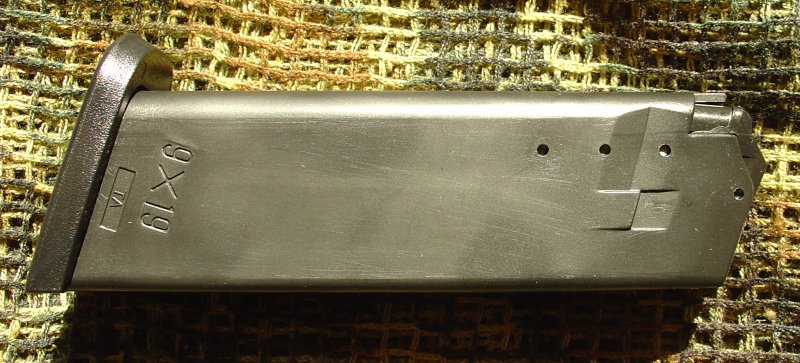
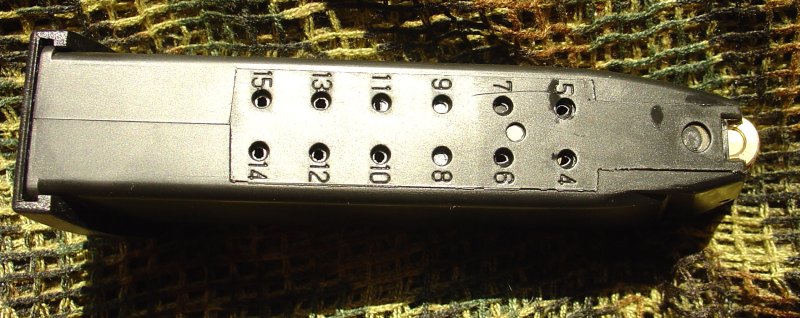
 Cartridges
CartridgesI have no clue if Tanaka had patent problems, or a brilliant idea, but they managed to create the most complicated cartridge I've seen so far.
Externally cartridge looks ok, like a 9mm cartridge, with an added bonus of being made of two metals, simulating a real-look bullet. Main body is the usual yellow-looking brass, but bullet tips are made of silver aluminum.
You can unscrew bullet top to find that internally things are... amusing. Even in such large cartridges Tanaka decided to use a 5mm cap. With such small cap diameter cartridge would need much thicker walls if it followed CP/PFC design. For some reason it does not have thicker walls, but there is a tube that you put inside the cartridge to make internal diameter 5mm. You insert tube into the cartride, a cap into the tube, and then a piston pin with o-ring into the tube, too.
That makes it 6 parts total: cart top, cart bottom, insert, tube, piston pin and o-ring. Plus a single 5mm cap, if you want to fire it.
Initial releases of USP in 1990's used different cartridges, with plastic tops. The were cheaper, but more delicate. See Jim's post below for a picture and information.
Mulberry Fields produces a conversion kit (detonator pin, return spring) that allows use of their cartridges (based on MGC CP system) of simpler design, with 7mm caps.
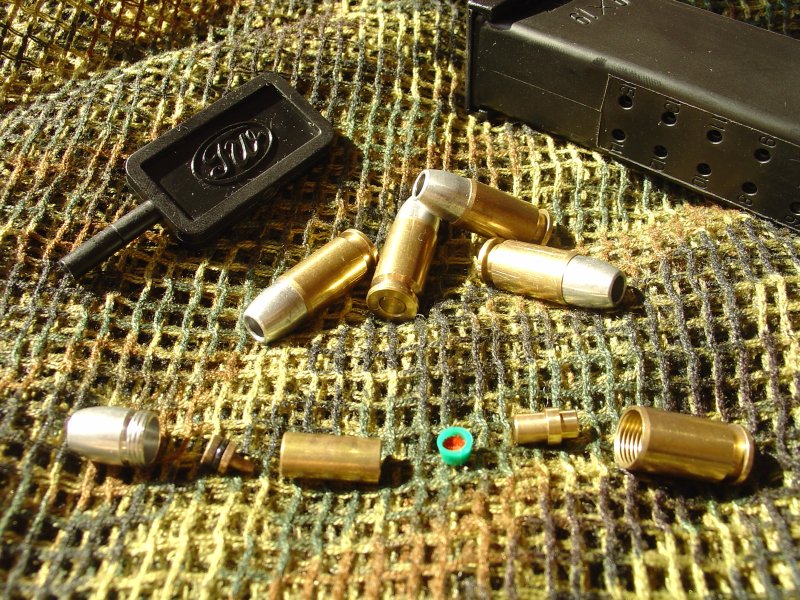 Firing
FiringLoad cartridges with caps, making sure you do not miss any of myriad parts.
Put cartridges into a magazine, load magazine into the grip, rack the slide to chamber the first cartridge.
At your leasure pull the trigger...
...in my own classification I use four major groups of modelgun "loudness", based on use inside apartment.
The first group is based on MGC Winchester, Hudson MadMax, Kokusai M10, so open shotguns and revolvers, where all energy goes towards BANG. These are ear-ringing loud!
The second group is based on MGC Colt 1911, the loudest blowback design I've heard. Ears ring, too, a bit shorter though.
The third group is based on MGC Beretta 96, nicely loud yet quieter than Colt 1911, does not make your ears ring.
The fourth group is based on MGC P08, Marushin Browning and P38 - fairly quiet, not much is heard in other rooms.
I find that pistols fall between the third and the fourth group and can be easily fired at home.
I expected Tanaka to be somewhere closer to the fourth group.
Guess what?! It is much louder than MGC Beretta, almost as loud as an MGC 1911! My ears were ringing after each shot. It was a very nice surprise to discover that Tanaka is so loud! It probably owes to small diameter of internal tube and therefore larger pressure generated by a 5mm cap.
Another thing that surprised me was very consistent ejection of the cartridges. They all landed in a spot about 30x30cm. With other pistols they are all over the place, with over 1m difference. Tanaka's consistency here most likely means that things are not left random during the firing sequence.
After firing all cartridges remember to thoroughly clean model and cartridges.
ProblemsTanaka models have reputation of being fragile. HW versions are heavier and feel better, but they more often break. ABS versions are... light, and break not as often. You need to take it into account when choosing which version to get.
So far I discovered one potential problem. Barrel is made of plastic, and it is connected to a return spring guide rod made of metal. Unfortunately there is a contact point (two of them), and when barrel is in the backwards position, it slams into the metal. This happens after every shot, and probably also when slide is pulled fully backwards. Metal scratches surface of the barrel, you end up with plastic shavings in the mechanism (locally) and slightly damaged barrel. Model you see here has fired about 30-40 cartridges.
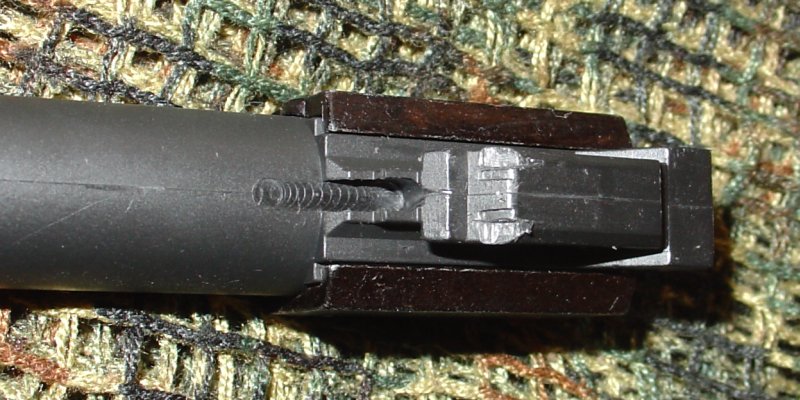


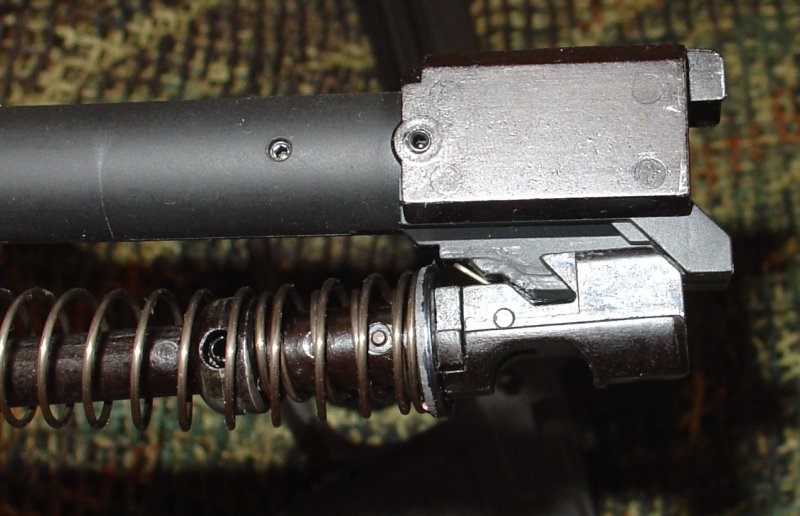
Weight distribution in this model is not too good, top-heavy, due to plastic magazine.
Magazine is plastic and just does not feel right, not to mention quite poor finish and lot of friction on the follower. I don't know why Tanaka has choosen this path :-/
Cartridge design is complicated, there are more parts to take care of when cleaning, but in practice it doesn't get much dirtier than other designs. One problem common with other designs using 5mm caps is that o-rings get blown off the piston and damage easily. So far for every 5 cartridges I get 1 or 2 blown off, not a good result.
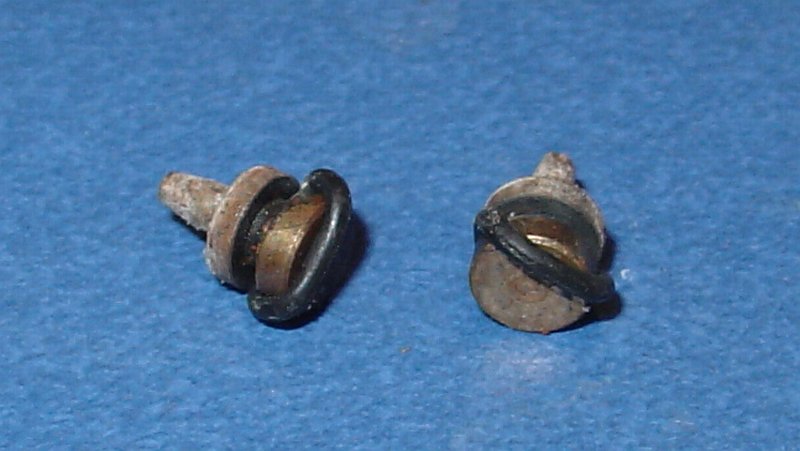 Basic disassembly
Basic disassemblyProcedure is fairly typical for modern pistols:
- Remove magazine, ensure that chamber is empty.
- move the slide back a little, so that cutout in slide is over slide lock lever.
- push slide lock lever from the right side of the frame, so it exits frame from the left side.
- store slide lock lever in a safe place.
- remove slide from the frame by pulling it towards the front.
- remove barrel, return rod and guide rod from the slide by tilting them and pulling out.
- using supplied hex key unscrew a grub screw that is on the left side, further from chamber (the close one holds metal sleeve to plastic barrel). Screw holds detonator pin.
- remove detonator pin from barrel. You might need to use pliers, as it sits very tight. Take care not to scratch/damage detonator pin.
Now you are ready for cleaning of the model. Take care of detonator pin, barrel, chamber area, as well as slide around ejection port. Remember to clean top of magazine, as well as cartridges. The sooner after shooting, the better.

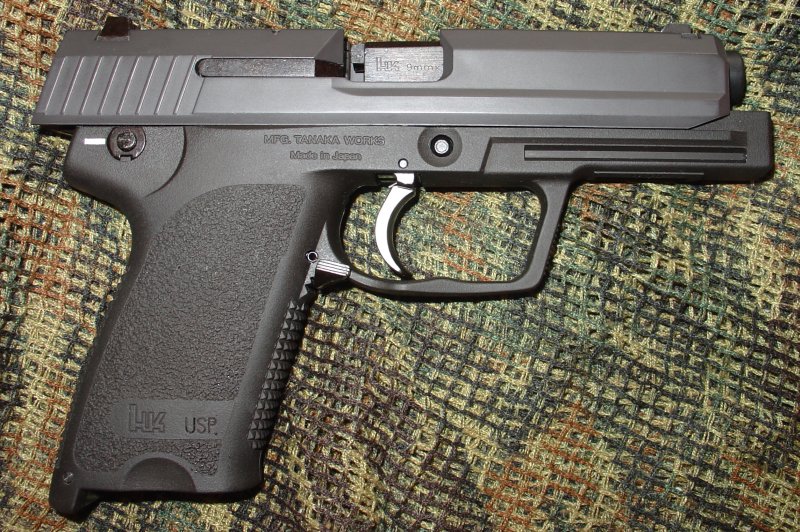
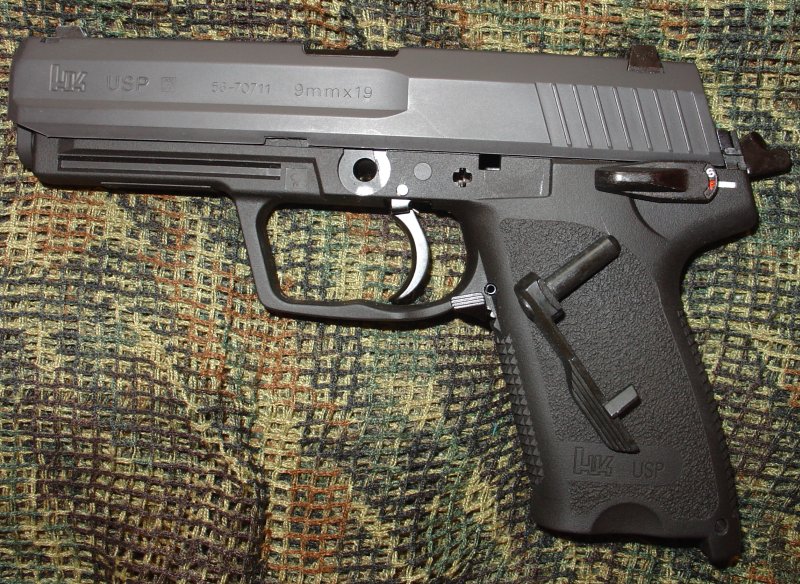
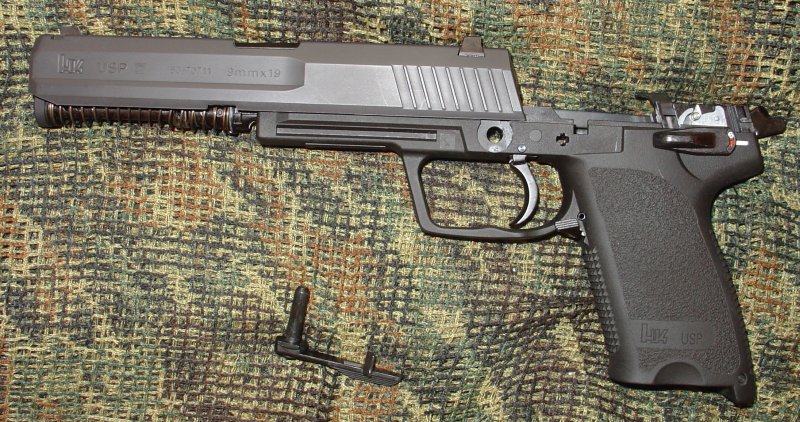
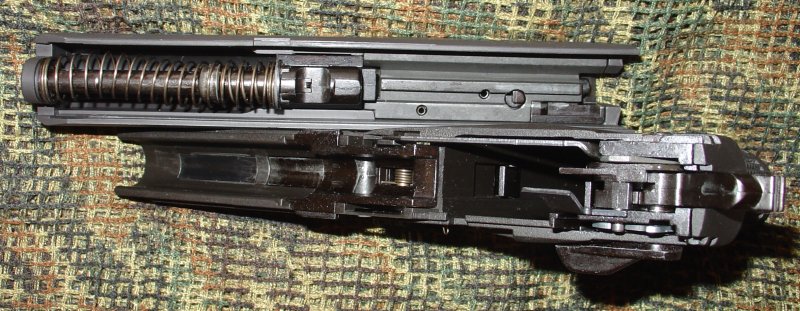
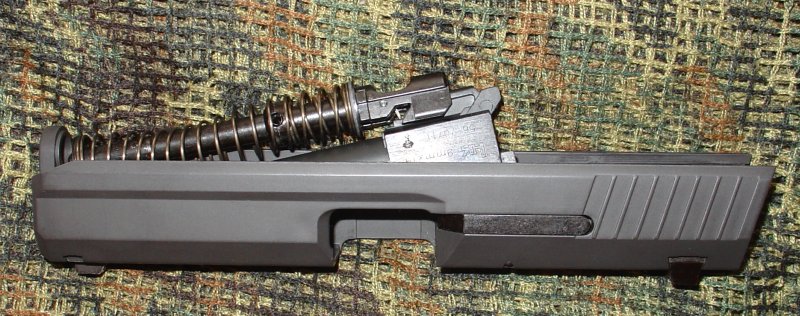
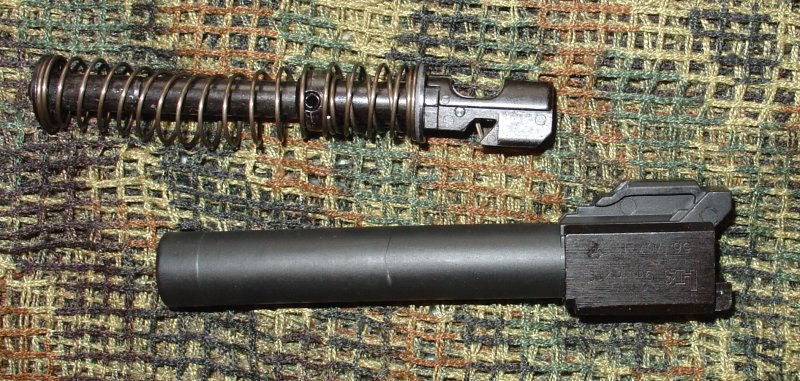

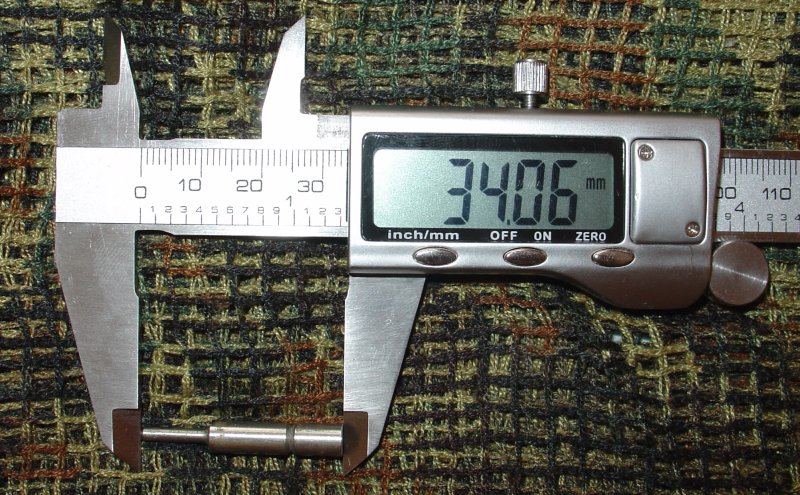
Assembly comments:
- you might find that it is easier to install barrel first (without a spring), and then return spring with its guide can be inserted into correct position.
- when pushing slide back onto frame make sure that parts sticking up from frame near hammer are held down and do not interfere with the slide.
OverallTanaka is known for producing models that no-one else did. Sig P226, H&K USP or Glocks were for a long time exclusive for this company, only recently WaShan introduced their line of Glocks and Sig P220, made of metal. While metal models are heavier and perhaps more satisfying to hold and fire, they are not as readily available. Tanaka models still offer very good quality with realistic markings. USP is also reputed to work better than their other pistol models, and suffer less breakages.
Choosing between airsoft and modelgun USP you might have mixed feelings. Airsoft ones have their advantages, modelguns have other. I am consistently in the modelgun camp though, preferring cap sound & sight of ejecting brass :-)
